UTS: BlueScope Steel Financial Reporting and Analysis Report
VerifiedAdded on 2023/06/11
|10
|3087
|53
Report
AI Summary
This report provides a detailed financial reporting analysis of BlueScope Steel Ltd, an Australian steel manufacturer. It identifies the company's key activities, including the production of steel slabs, hot rolled coil, and coated steel products, and examines the accounting policies it follows, such as revenue recognition, inventory valuation, and foreign currency transaction accounting. The report discusses the flexibility BlueScope Steel has in choosing accounting policies within GAAP and IFRS frameworks and analyzes the company's accounting strategies related to revenue recognition, basis of preparation, foreign currency transactions, and asset valuation. It also highlights important disclosures in the financial statements, including segment reporting, revenue recognition details, income tax information, and tangible/intangible asset treatments. The report further touches upon potential questionable accounting numbers and concludes with an analysis of BlueScope Steel's overall financial performance. Students can find this and other helpful resources on Desklib.
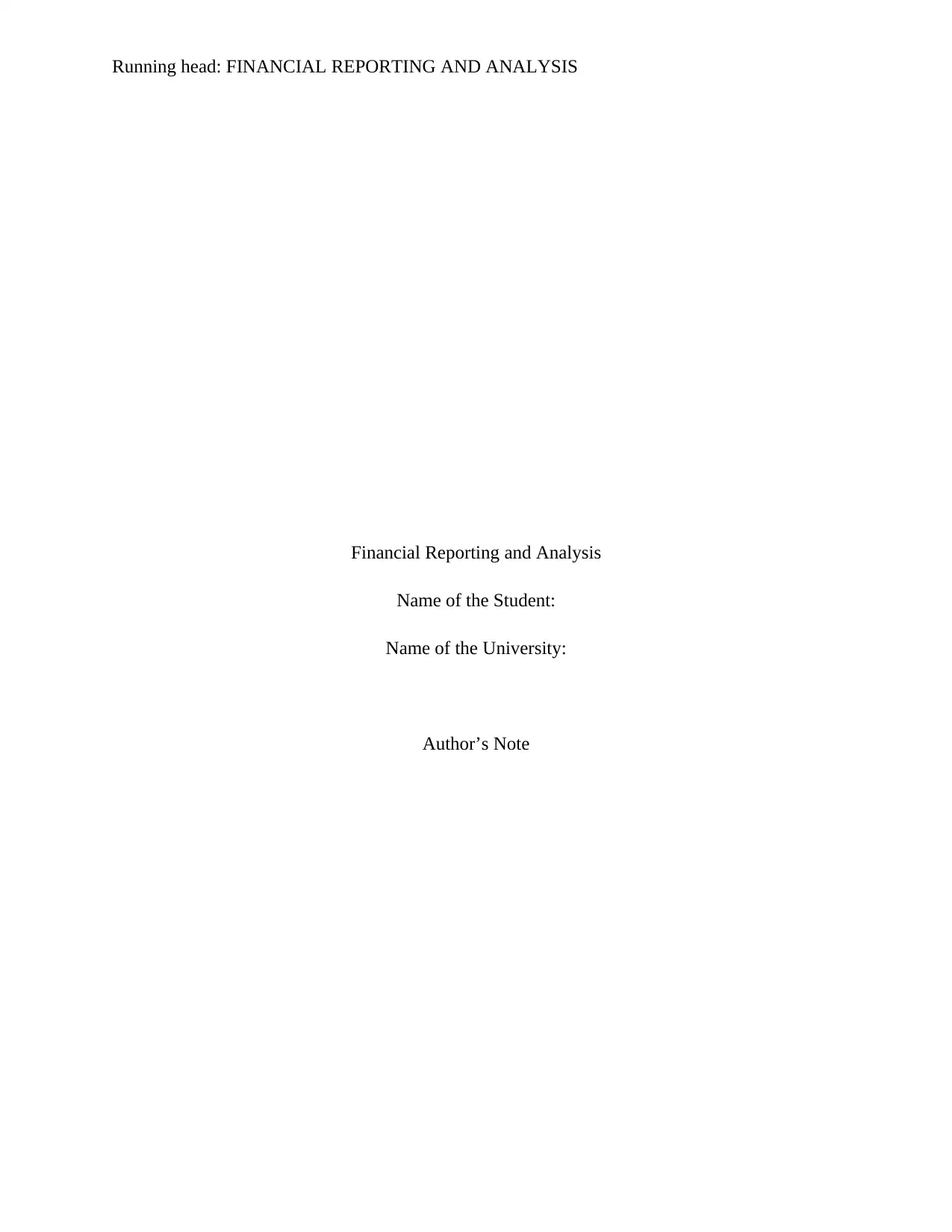
Running head: FINANCIAL REPORTING AND ANALYSIS
Financial Reporting and Analysis
Name of the Student:
Name of the University:
Author’s Note
Financial Reporting and Analysis
Name of the Student:
Name of the University:
Author’s Note
Paraphrase This Document
Need a fresh take? Get an instant paraphrase of this document with our AI Paraphraser
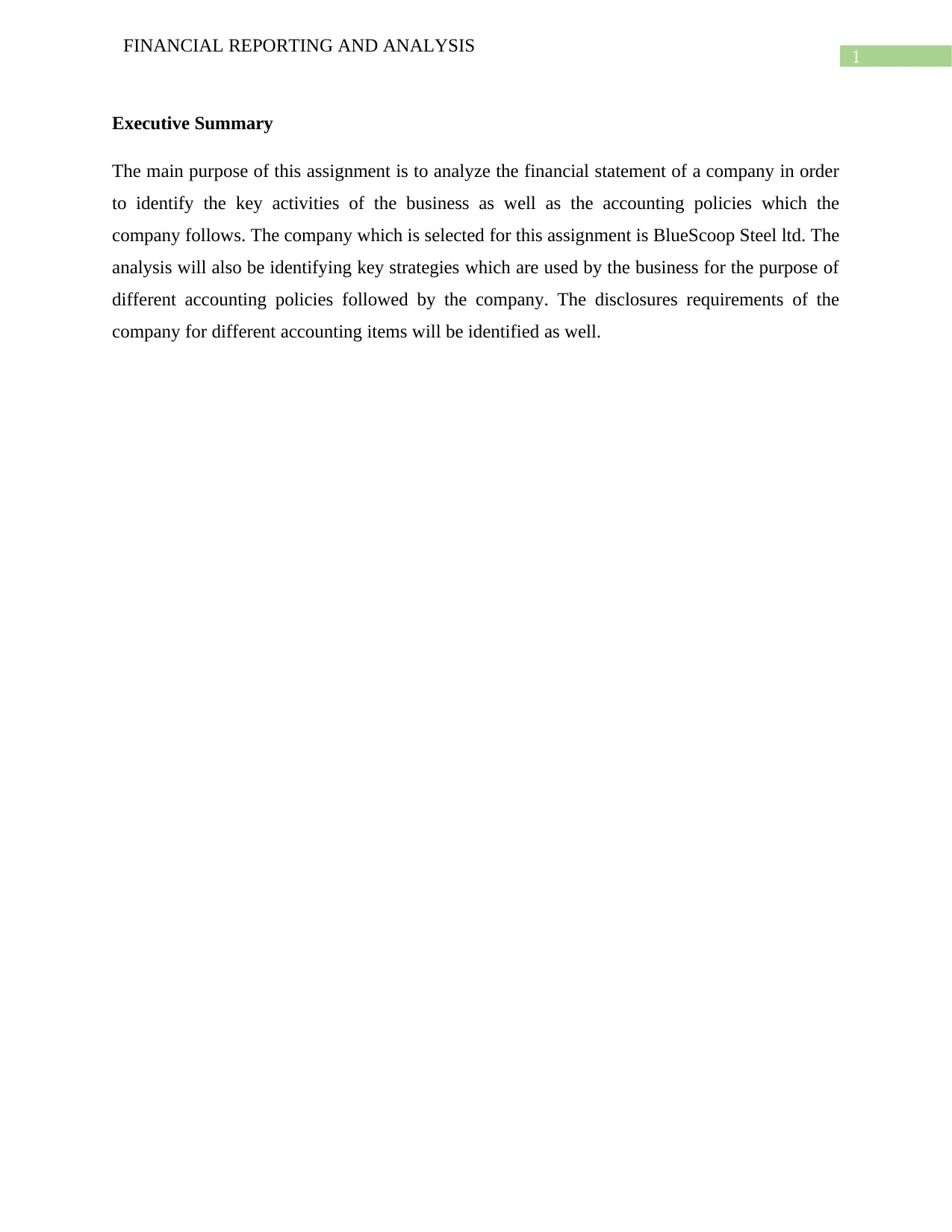
1
FINANCIAL REPORTING AND ANALYSIS
Executive Summary
The main purpose of this assignment is to analyze the financial statement of a company in order
to identify the key activities of the business as well as the accounting policies which the
company follows. The company which is selected for this assignment is BlueScoop Steel ltd. The
analysis will also be identifying key strategies which are used by the business for the purpose of
different accounting policies followed by the company. The disclosures requirements of the
company for different accounting items will be identified as well.
FINANCIAL REPORTING AND ANALYSIS
Executive Summary
The main purpose of this assignment is to analyze the financial statement of a company in order
to identify the key activities of the business as well as the accounting policies which the
company follows. The company which is selected for this assignment is BlueScoop Steel ltd. The
analysis will also be identifying key strategies which are used by the business for the purpose of
different accounting policies followed by the company. The disclosures requirements of the
company for different accounting items will be identified as well.
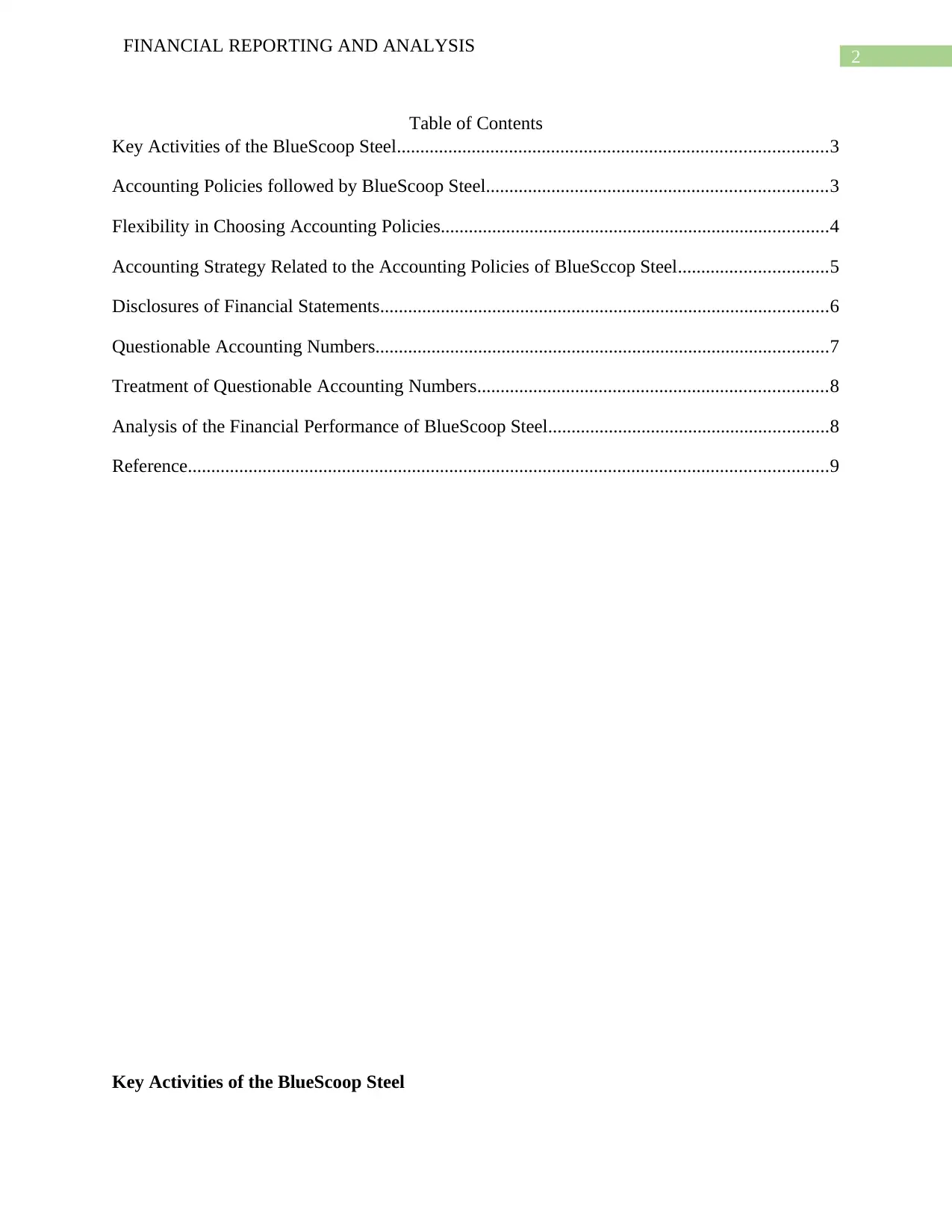
2
FINANCIAL REPORTING AND ANALYSIS
Table of Contents
Key Activities of the BlueScoop Steel............................................................................................3
Accounting Policies followed by BlueScoop Steel.........................................................................3
Flexibility in Choosing Accounting Policies...................................................................................4
Accounting Strategy Related to the Accounting Policies of BlueSccop Steel................................5
Disclosures of Financial Statements................................................................................................6
Questionable Accounting Numbers.................................................................................................7
Treatment of Questionable Accounting Numbers...........................................................................8
Analysis of the Financial Performance of BlueScoop Steel............................................................8
Reference.........................................................................................................................................9
Key Activities of the BlueScoop Steel
FINANCIAL REPORTING AND ANALYSIS
Table of Contents
Key Activities of the BlueScoop Steel............................................................................................3
Accounting Policies followed by BlueScoop Steel.........................................................................3
Flexibility in Choosing Accounting Policies...................................................................................4
Accounting Strategy Related to the Accounting Policies of BlueSccop Steel................................5
Disclosures of Financial Statements................................................................................................6
Questionable Accounting Numbers.................................................................................................7
Treatment of Questionable Accounting Numbers...........................................................................8
Analysis of the Financial Performance of BlueScoop Steel............................................................8
Reference.........................................................................................................................................9
Key Activities of the BlueScoop Steel
⊘ This is a preview!⊘
Do you want full access?
Subscribe today to unlock all pages.

Trusted by 1+ million students worldwide
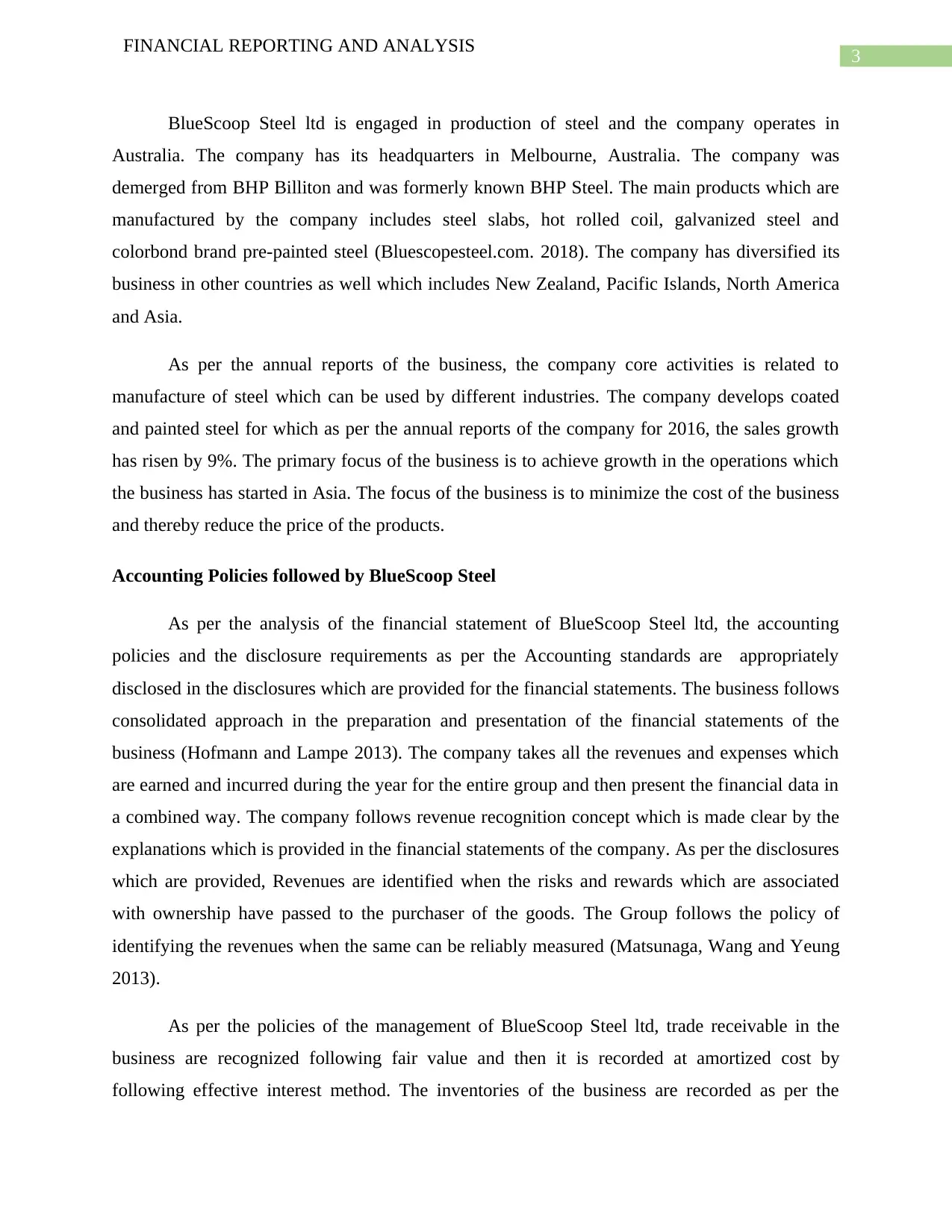
3
FINANCIAL REPORTING AND ANALYSIS
BlueScoop Steel ltd is engaged in production of steel and the company operates in
Australia. The company has its headquarters in Melbourne, Australia. The company was
demerged from BHP Billiton and was formerly known BHP Steel. The main products which are
manufactured by the company includes steel slabs, hot rolled coil, galvanized steel and
colorbond brand pre-painted steel (Bluescopesteel.com. 2018). The company has diversified its
business in other countries as well which includes New Zealand, Pacific Islands, North America
and Asia.
As per the annual reports of the business, the company core activities is related to
manufacture of steel which can be used by different industries. The company develops coated
and painted steel for which as per the annual reports of the company for 2016, the sales growth
has risen by 9%. The primary focus of the business is to achieve growth in the operations which
the business has started in Asia. The focus of the business is to minimize the cost of the business
and thereby reduce the price of the products.
Accounting Policies followed by BlueScoop Steel
As per the analysis of the financial statement of BlueScoop Steel ltd, the accounting
policies and the disclosure requirements as per the Accounting standards are appropriately
disclosed in the disclosures which are provided for the financial statements. The business follows
consolidated approach in the preparation and presentation of the financial statements of the
business (Hofmann and Lampe 2013). The company takes all the revenues and expenses which
are earned and incurred during the year for the entire group and then present the financial data in
a combined way. The company follows revenue recognition concept which is made clear by the
explanations which is provided in the financial statements of the company. As per the disclosures
which are provided, Revenues are identified when the risks and rewards which are associated
with ownership have passed to the purchaser of the goods. The Group follows the policy of
identifying the revenues when the same can be reliably measured (Matsunaga, Wang and Yeung
2013).
As per the policies of the management of BlueScoop Steel ltd, trade receivable in the
business are recognized following fair value and then it is recorded at amortized cost by
following effective interest method. The inventories of the business are recorded as per the
FINANCIAL REPORTING AND ANALYSIS
BlueScoop Steel ltd is engaged in production of steel and the company operates in
Australia. The company has its headquarters in Melbourne, Australia. The company was
demerged from BHP Billiton and was formerly known BHP Steel. The main products which are
manufactured by the company includes steel slabs, hot rolled coil, galvanized steel and
colorbond brand pre-painted steel (Bluescopesteel.com. 2018). The company has diversified its
business in other countries as well which includes New Zealand, Pacific Islands, North America
and Asia.
As per the annual reports of the business, the company core activities is related to
manufacture of steel which can be used by different industries. The company develops coated
and painted steel for which as per the annual reports of the company for 2016, the sales growth
has risen by 9%. The primary focus of the business is to achieve growth in the operations which
the business has started in Asia. The focus of the business is to minimize the cost of the business
and thereby reduce the price of the products.
Accounting Policies followed by BlueScoop Steel
As per the analysis of the financial statement of BlueScoop Steel ltd, the accounting
policies and the disclosure requirements as per the Accounting standards are appropriately
disclosed in the disclosures which are provided for the financial statements. The business follows
consolidated approach in the preparation and presentation of the financial statements of the
business (Hofmann and Lampe 2013). The company takes all the revenues and expenses which
are earned and incurred during the year for the entire group and then present the financial data in
a combined way. The company follows revenue recognition concept which is made clear by the
explanations which is provided in the financial statements of the company. As per the disclosures
which are provided, Revenues are identified when the risks and rewards which are associated
with ownership have passed to the purchaser of the goods. The Group follows the policy of
identifying the revenues when the same can be reliably measured (Matsunaga, Wang and Yeung
2013).
As per the policies of the management of BlueScoop Steel ltd, trade receivable in the
business are recognized following fair value and then it is recorded at amortized cost by
following effective interest method. The inventories of the business are recorded as per the
Paraphrase This Document
Need a fresh take? Get an instant paraphrase of this document with our AI Paraphraser
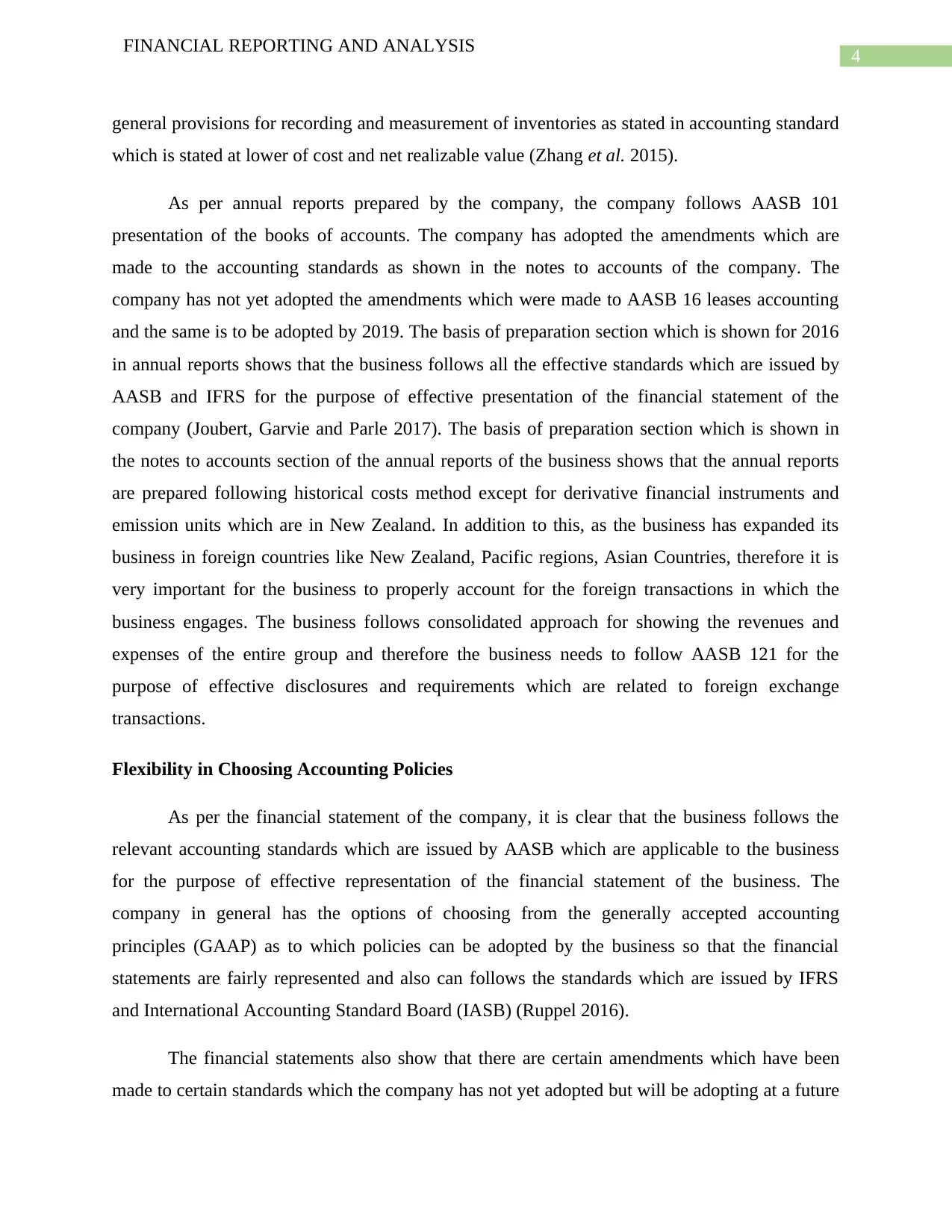
4
FINANCIAL REPORTING AND ANALYSIS
general provisions for recording and measurement of inventories as stated in accounting standard
which is stated at lower of cost and net realizable value (Zhang et al. 2015).
As per annual reports prepared by the company, the company follows AASB 101
presentation of the books of accounts. The company has adopted the amendments which are
made to the accounting standards as shown in the notes to accounts of the company. The
company has not yet adopted the amendments which were made to AASB 16 leases accounting
and the same is to be adopted by 2019. The basis of preparation section which is shown for 2016
in annual reports shows that the business follows all the effective standards which are issued by
AASB and IFRS for the purpose of effective presentation of the financial statement of the
company (Joubert, Garvie and Parle 2017). The basis of preparation section which is shown in
the notes to accounts section of the annual reports of the business shows that the annual reports
are prepared following historical costs method except for derivative financial instruments and
emission units which are in New Zealand. In addition to this, as the business has expanded its
business in foreign countries like New Zealand, Pacific regions, Asian Countries, therefore it is
very important for the business to properly account for the foreign transactions in which the
business engages. The business follows consolidated approach for showing the revenues and
expenses of the entire group and therefore the business needs to follow AASB 121 for the
purpose of effective disclosures and requirements which are related to foreign exchange
transactions.
Flexibility in Choosing Accounting Policies
As per the financial statement of the company, it is clear that the business follows the
relevant accounting standards which are issued by AASB which are applicable to the business
for the purpose of effective representation of the financial statement of the business. The
company in general has the options of choosing from the generally accepted accounting
principles (GAAP) as to which policies can be adopted by the business so that the financial
statements are fairly represented and also can follows the standards which are issued by IFRS
and International Accounting Standard Board (IASB) (Ruppel 2016).
The financial statements also show that there are certain amendments which have been
made to certain standards which the company has not yet adopted but will be adopting at a future
FINANCIAL REPORTING AND ANALYSIS
general provisions for recording and measurement of inventories as stated in accounting standard
which is stated at lower of cost and net realizable value (Zhang et al. 2015).
As per annual reports prepared by the company, the company follows AASB 101
presentation of the books of accounts. The company has adopted the amendments which are
made to the accounting standards as shown in the notes to accounts of the company. The
company has not yet adopted the amendments which were made to AASB 16 leases accounting
and the same is to be adopted by 2019. The basis of preparation section which is shown for 2016
in annual reports shows that the business follows all the effective standards which are issued by
AASB and IFRS for the purpose of effective presentation of the financial statement of the
company (Joubert, Garvie and Parle 2017). The basis of preparation section which is shown in
the notes to accounts section of the annual reports of the business shows that the annual reports
are prepared following historical costs method except for derivative financial instruments and
emission units which are in New Zealand. In addition to this, as the business has expanded its
business in foreign countries like New Zealand, Pacific regions, Asian Countries, therefore it is
very important for the business to properly account for the foreign transactions in which the
business engages. The business follows consolidated approach for showing the revenues and
expenses of the entire group and therefore the business needs to follow AASB 121 for the
purpose of effective disclosures and requirements which are related to foreign exchange
transactions.
Flexibility in Choosing Accounting Policies
As per the financial statement of the company, it is clear that the business follows the
relevant accounting standards which are issued by AASB which are applicable to the business
for the purpose of effective representation of the financial statement of the business. The
company in general has the options of choosing from the generally accepted accounting
principles (GAAP) as to which policies can be adopted by the business so that the financial
statements are fairly represented and also can follows the standards which are issued by IFRS
and International Accounting Standard Board (IASB) (Ruppel 2016).
The financial statements also show that there are certain amendments which have been
made to certain standards which the company has not yet adopted but will be adopting at a future
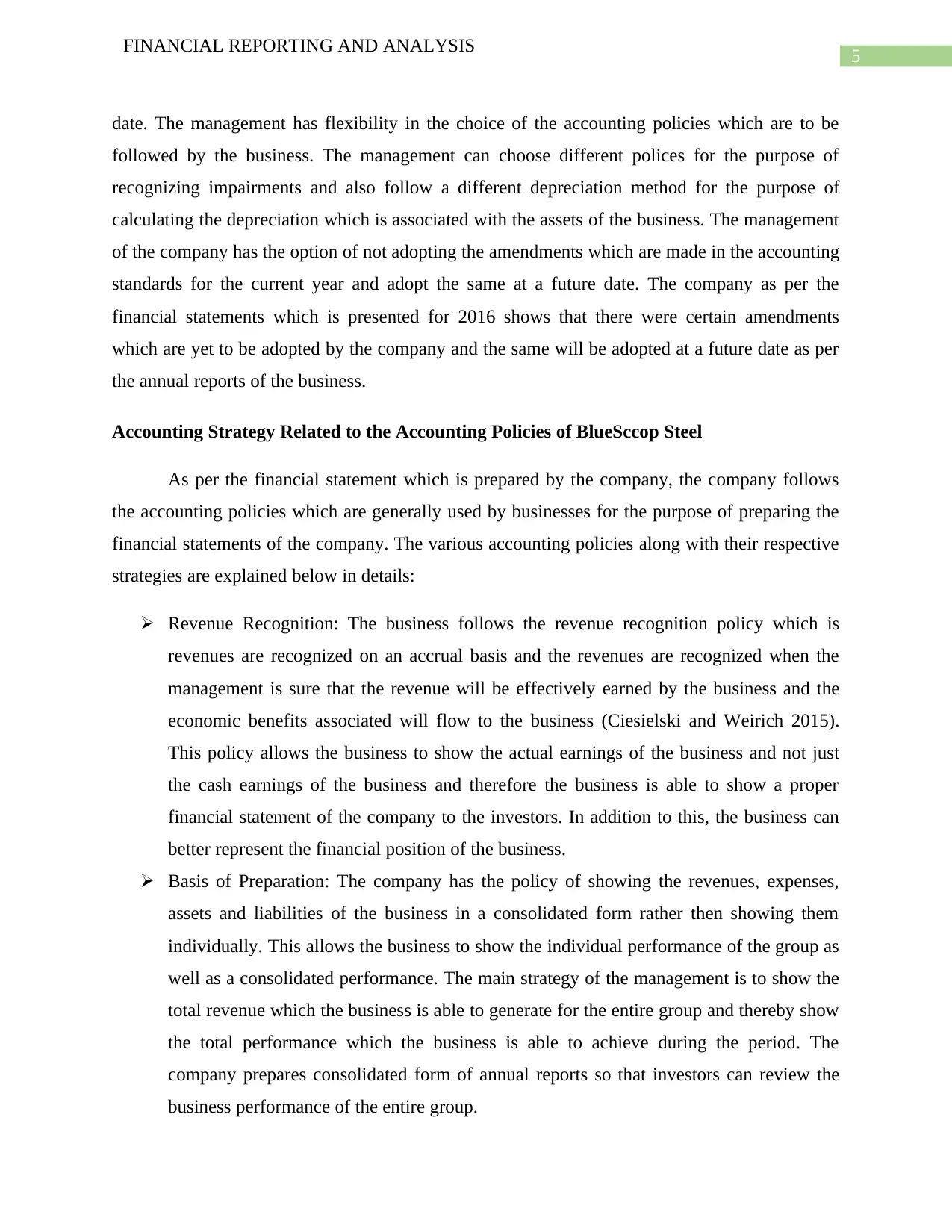
5
FINANCIAL REPORTING AND ANALYSIS
date. The management has flexibility in the choice of the accounting policies which are to be
followed by the business. The management can choose different polices for the purpose of
recognizing impairments and also follow a different depreciation method for the purpose of
calculating the depreciation which is associated with the assets of the business. The management
of the company has the option of not adopting the amendments which are made in the accounting
standards for the current year and adopt the same at a future date. The company as per the
financial statements which is presented for 2016 shows that there were certain amendments
which are yet to be adopted by the company and the same will be adopted at a future date as per
the annual reports of the business.
Accounting Strategy Related to the Accounting Policies of BlueSccop Steel
As per the financial statement which is prepared by the company, the company follows
the accounting policies which are generally used by businesses for the purpose of preparing the
financial statements of the company. The various accounting policies along with their respective
strategies are explained below in details:
Revenue Recognition: The business follows the revenue recognition policy which is
revenues are recognized on an accrual basis and the revenues are recognized when the
management is sure that the revenue will be effectively earned by the business and the
economic benefits associated will flow to the business (Ciesielski and Weirich 2015).
This policy allows the business to show the actual earnings of the business and not just
the cash earnings of the business and therefore the business is able to show a proper
financial statement of the company to the investors. In addition to this, the business can
better represent the financial position of the business.
Basis of Preparation: The company has the policy of showing the revenues, expenses,
assets and liabilities of the business in a consolidated form rather then showing them
individually. This allows the business to show the individual performance of the group as
well as a consolidated performance. The main strategy of the management is to show the
total revenue which the business is able to generate for the entire group and thereby show
the total performance which the business is able to achieve during the period. The
company prepares consolidated form of annual reports so that investors can review the
business performance of the entire group.
FINANCIAL REPORTING AND ANALYSIS
date. The management has flexibility in the choice of the accounting policies which are to be
followed by the business. The management can choose different polices for the purpose of
recognizing impairments and also follow a different depreciation method for the purpose of
calculating the depreciation which is associated with the assets of the business. The management
of the company has the option of not adopting the amendments which are made in the accounting
standards for the current year and adopt the same at a future date. The company as per the
financial statements which is presented for 2016 shows that there were certain amendments
which are yet to be adopted by the company and the same will be adopted at a future date as per
the annual reports of the business.
Accounting Strategy Related to the Accounting Policies of BlueSccop Steel
As per the financial statement which is prepared by the company, the company follows
the accounting policies which are generally used by businesses for the purpose of preparing the
financial statements of the company. The various accounting policies along with their respective
strategies are explained below in details:
Revenue Recognition: The business follows the revenue recognition policy which is
revenues are recognized on an accrual basis and the revenues are recognized when the
management is sure that the revenue will be effectively earned by the business and the
economic benefits associated will flow to the business (Ciesielski and Weirich 2015).
This policy allows the business to show the actual earnings of the business and not just
the cash earnings of the business and therefore the business is able to show a proper
financial statement of the company to the investors. In addition to this, the business can
better represent the financial position of the business.
Basis of Preparation: The company has the policy of showing the revenues, expenses,
assets and liabilities of the business in a consolidated form rather then showing them
individually. This allows the business to show the individual performance of the group as
well as a consolidated performance. The main strategy of the management is to show the
total revenue which the business is able to generate for the entire group and thereby show
the total performance which the business is able to achieve during the period. The
company prepares consolidated form of annual reports so that investors can review the
business performance of the entire group.
⊘ This is a preview!⊘
Do you want full access?
Subscribe today to unlock all pages.

Trusted by 1+ million students worldwide
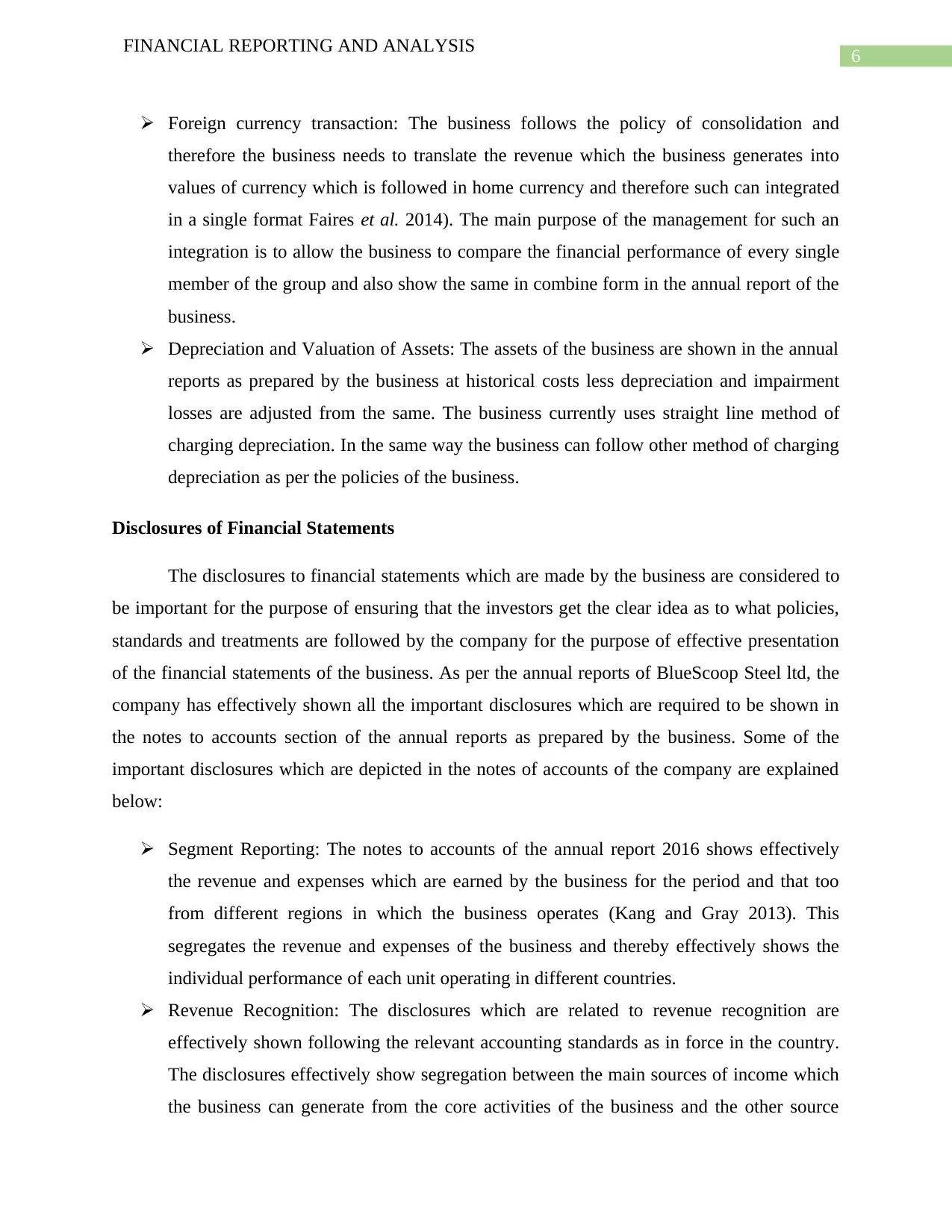
6
FINANCIAL REPORTING AND ANALYSIS
Foreign currency transaction: The business follows the policy of consolidation and
therefore the business needs to translate the revenue which the business generates into
values of currency which is followed in home currency and therefore such can integrated
in a single format Faires et al. 2014). The main purpose of the management for such an
integration is to allow the business to compare the financial performance of every single
member of the group and also show the same in combine form in the annual report of the
business.
Depreciation and Valuation of Assets: The assets of the business are shown in the annual
reports as prepared by the business at historical costs less depreciation and impairment
losses are adjusted from the same. The business currently uses straight line method of
charging depreciation. In the same way the business can follow other method of charging
depreciation as per the policies of the business.
Disclosures of Financial Statements
The disclosures to financial statements which are made by the business are considered to
be important for the purpose of ensuring that the investors get the clear idea as to what policies,
standards and treatments are followed by the company for the purpose of effective presentation
of the financial statements of the business. As per the annual reports of BlueScoop Steel ltd, the
company has effectively shown all the important disclosures which are required to be shown in
the notes to accounts section of the annual reports as prepared by the business. Some of the
important disclosures which are depicted in the notes of accounts of the company are explained
below:
Segment Reporting: The notes to accounts of the annual report 2016 shows effectively
the revenue and expenses which are earned by the business for the period and that too
from different regions in which the business operates (Kang and Gray 2013). This
segregates the revenue and expenses of the business and thereby effectively shows the
individual performance of each unit operating in different countries.
Revenue Recognition: The disclosures which are related to revenue recognition are
effectively shown following the relevant accounting standards as in force in the country.
The disclosures effectively show segregation between the main sources of income which
the business can generate from the core activities of the business and the other source
FINANCIAL REPORTING AND ANALYSIS
Foreign currency transaction: The business follows the policy of consolidation and
therefore the business needs to translate the revenue which the business generates into
values of currency which is followed in home currency and therefore such can integrated
in a single format Faires et al. 2014). The main purpose of the management for such an
integration is to allow the business to compare the financial performance of every single
member of the group and also show the same in combine form in the annual report of the
business.
Depreciation and Valuation of Assets: The assets of the business are shown in the annual
reports as prepared by the business at historical costs less depreciation and impairment
losses are adjusted from the same. The business currently uses straight line method of
charging depreciation. In the same way the business can follow other method of charging
depreciation as per the policies of the business.
Disclosures of Financial Statements
The disclosures to financial statements which are made by the business are considered to
be important for the purpose of ensuring that the investors get the clear idea as to what policies,
standards and treatments are followed by the company for the purpose of effective presentation
of the financial statements of the business. As per the annual reports of BlueScoop Steel ltd, the
company has effectively shown all the important disclosures which are required to be shown in
the notes to accounts section of the annual reports as prepared by the business. Some of the
important disclosures which are depicted in the notes of accounts of the company are explained
below:
Segment Reporting: The notes to accounts of the annual report 2016 shows effectively
the revenue and expenses which are earned by the business for the period and that too
from different regions in which the business operates (Kang and Gray 2013). This
segregates the revenue and expenses of the business and thereby effectively shows the
individual performance of each unit operating in different countries.
Revenue Recognition: The disclosures which are related to revenue recognition are
effectively shown following the relevant accounting standards as in force in the country.
The disclosures effectively show segregation between the main sources of income which
the business can generate from the core activities of the business and the other source
Paraphrase This Document
Need a fresh take? Get an instant paraphrase of this document with our AI Paraphraser
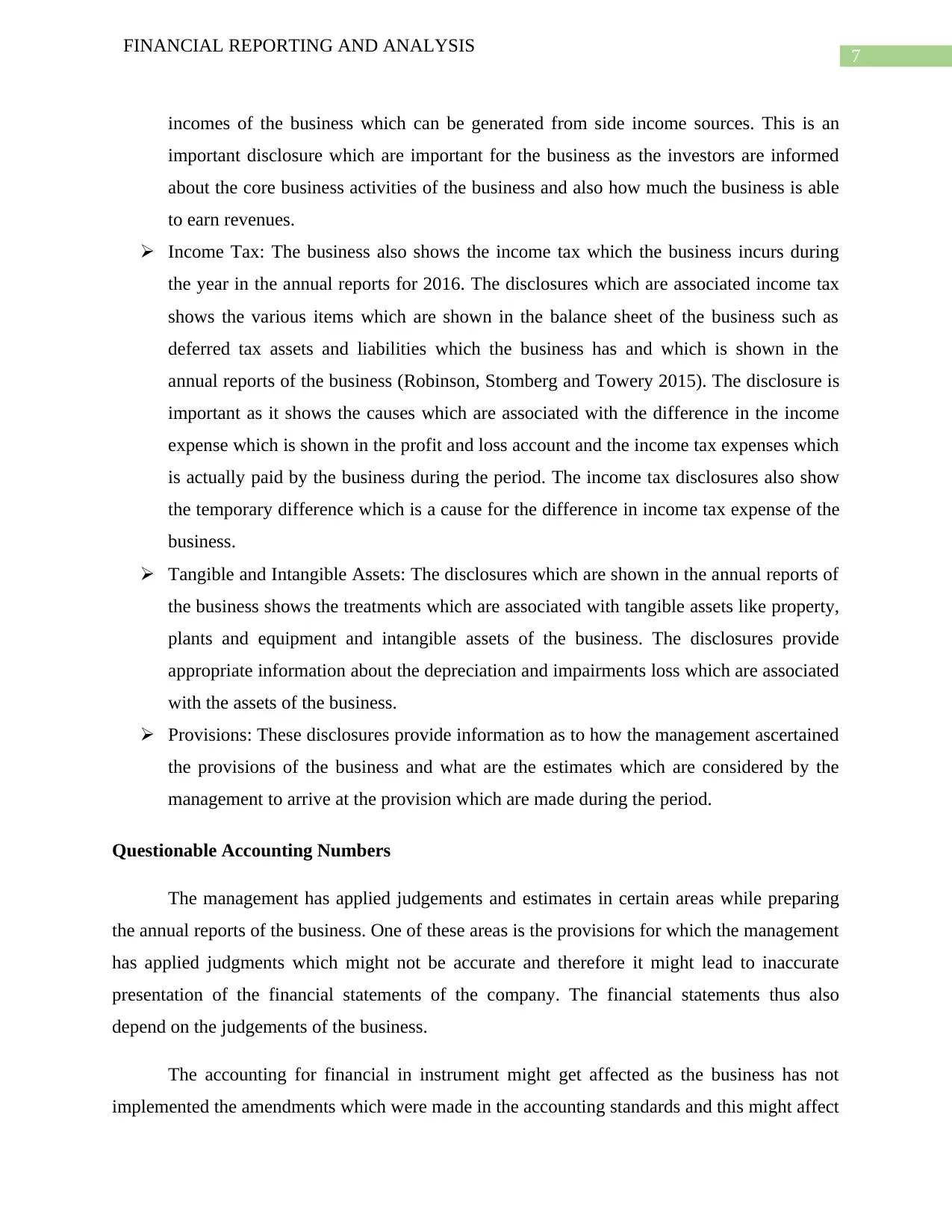
7
FINANCIAL REPORTING AND ANALYSIS
incomes of the business which can be generated from side income sources. This is an
important disclosure which are important for the business as the investors are informed
about the core business activities of the business and also how much the business is able
to earn revenues.
Income Tax: The business also shows the income tax which the business incurs during
the year in the annual reports for 2016. The disclosures which are associated income tax
shows the various items which are shown in the balance sheet of the business such as
deferred tax assets and liabilities which the business has and which is shown in the
annual reports of the business (Robinson, Stomberg and Towery 2015). The disclosure is
important as it shows the causes which are associated with the difference in the income
expense which is shown in the profit and loss account and the income tax expenses which
is actually paid by the business during the period. The income tax disclosures also show
the temporary difference which is a cause for the difference in income tax expense of the
business.
Tangible and Intangible Assets: The disclosures which are shown in the annual reports of
the business shows the treatments which are associated with tangible assets like property,
plants and equipment and intangible assets of the business. The disclosures provide
appropriate information about the depreciation and impairments loss which are associated
with the assets of the business.
Provisions: These disclosures provide information as to how the management ascertained
the provisions of the business and what are the estimates which are considered by the
management to arrive at the provision which are made during the period.
Questionable Accounting Numbers
The management has applied judgements and estimates in certain areas while preparing
the annual reports of the business. One of these areas is the provisions for which the management
has applied judgments which might not be accurate and therefore it might lead to inaccurate
presentation of the financial statements of the company. The financial statements thus also
depend on the judgements of the business.
The accounting for financial in instrument might get affected as the business has not
implemented the amendments which were made in the accounting standards and this might affect
FINANCIAL REPORTING AND ANALYSIS
incomes of the business which can be generated from side income sources. This is an
important disclosure which are important for the business as the investors are informed
about the core business activities of the business and also how much the business is able
to earn revenues.
Income Tax: The business also shows the income tax which the business incurs during
the year in the annual reports for 2016. The disclosures which are associated income tax
shows the various items which are shown in the balance sheet of the business such as
deferred tax assets and liabilities which the business has and which is shown in the
annual reports of the business (Robinson, Stomberg and Towery 2015). The disclosure is
important as it shows the causes which are associated with the difference in the income
expense which is shown in the profit and loss account and the income tax expenses which
is actually paid by the business during the period. The income tax disclosures also show
the temporary difference which is a cause for the difference in income tax expense of the
business.
Tangible and Intangible Assets: The disclosures which are shown in the annual reports of
the business shows the treatments which are associated with tangible assets like property,
plants and equipment and intangible assets of the business. The disclosures provide
appropriate information about the depreciation and impairments loss which are associated
with the assets of the business.
Provisions: These disclosures provide information as to how the management ascertained
the provisions of the business and what are the estimates which are considered by the
management to arrive at the provision which are made during the period.
Questionable Accounting Numbers
The management has applied judgements and estimates in certain areas while preparing
the annual reports of the business. One of these areas is the provisions for which the management
has applied judgments which might not be accurate and therefore it might lead to inaccurate
presentation of the financial statements of the company. The financial statements thus also
depend on the judgements of the business.
The accounting for financial in instrument might get affected as the business has not
implemented the amendments which were made in the accounting standards and this might affect
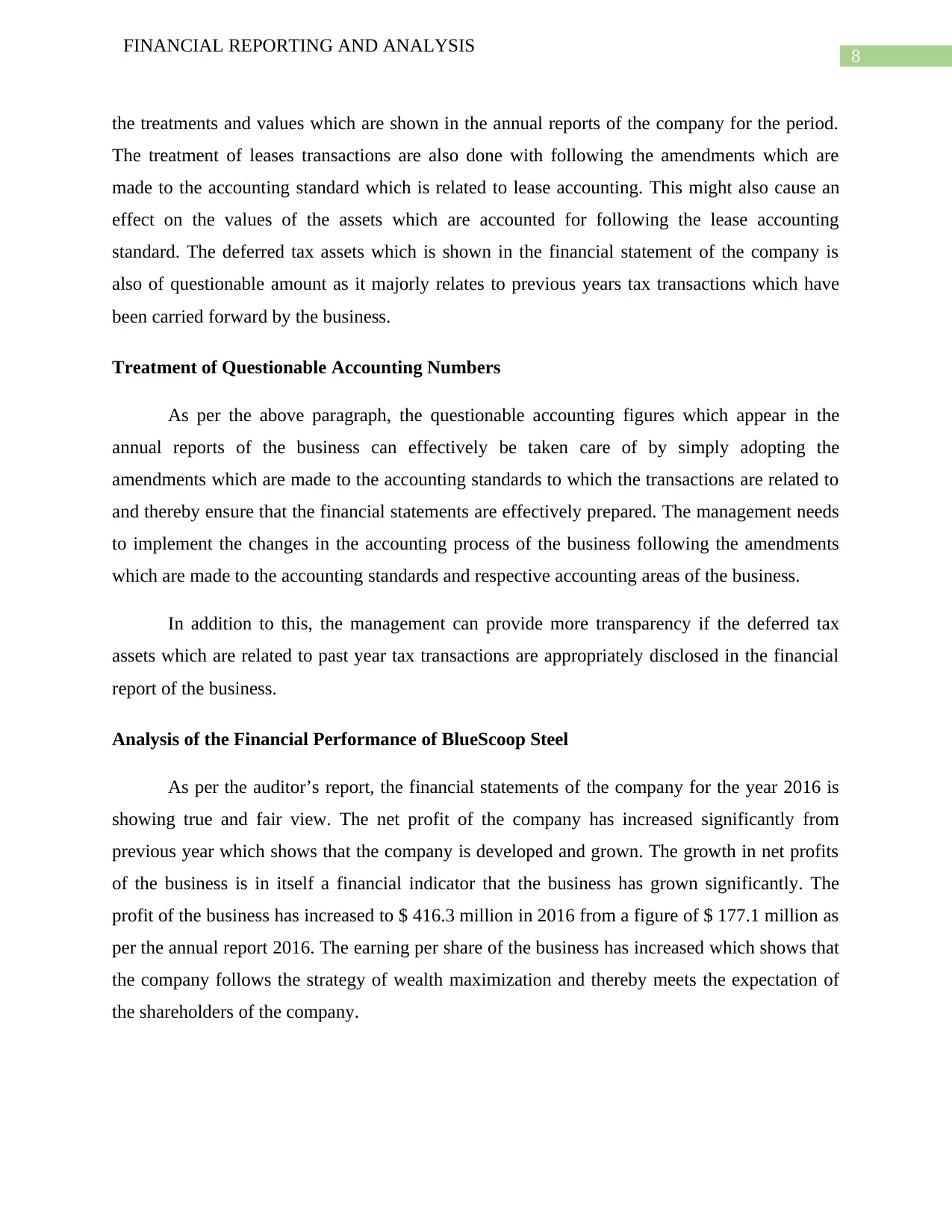
8
FINANCIAL REPORTING AND ANALYSIS
the treatments and values which are shown in the annual reports of the company for the period.
The treatment of leases transactions are also done with following the amendments which are
made to the accounting standard which is related to lease accounting. This might also cause an
effect on the values of the assets which are accounted for following the lease accounting
standard. The deferred tax assets which is shown in the financial statement of the company is
also of questionable amount as it majorly relates to previous years tax transactions which have
been carried forward by the business.
Treatment of Questionable Accounting Numbers
As per the above paragraph, the questionable accounting figures which appear in the
annual reports of the business can effectively be taken care of by simply adopting the
amendments which are made to the accounting standards to which the transactions are related to
and thereby ensure that the financial statements are effectively prepared. The management needs
to implement the changes in the accounting process of the business following the amendments
which are made to the accounting standards and respective accounting areas of the business.
In addition to this, the management can provide more transparency if the deferred tax
assets which are related to past year tax transactions are appropriately disclosed in the financial
report of the business.
Analysis of the Financial Performance of BlueScoop Steel
As per the auditor’s report, the financial statements of the company for the year 2016 is
showing true and fair view. The net profit of the company has increased significantly from
previous year which shows that the company is developed and grown. The growth in net profits
of the business is in itself a financial indicator that the business has grown significantly. The
profit of the business has increased to $ 416.3 million in 2016 from a figure of $ 177.1 million as
per the annual report 2016. The earning per share of the business has increased which shows that
the company follows the strategy of wealth maximization and thereby meets the expectation of
the shareholders of the company.
FINANCIAL REPORTING AND ANALYSIS
the treatments and values which are shown in the annual reports of the company for the period.
The treatment of leases transactions are also done with following the amendments which are
made to the accounting standard which is related to lease accounting. This might also cause an
effect on the values of the assets which are accounted for following the lease accounting
standard. The deferred tax assets which is shown in the financial statement of the company is
also of questionable amount as it majorly relates to previous years tax transactions which have
been carried forward by the business.
Treatment of Questionable Accounting Numbers
As per the above paragraph, the questionable accounting figures which appear in the
annual reports of the business can effectively be taken care of by simply adopting the
amendments which are made to the accounting standards to which the transactions are related to
and thereby ensure that the financial statements are effectively prepared. The management needs
to implement the changes in the accounting process of the business following the amendments
which are made to the accounting standards and respective accounting areas of the business.
In addition to this, the management can provide more transparency if the deferred tax
assets which are related to past year tax transactions are appropriately disclosed in the financial
report of the business.
Analysis of the Financial Performance of BlueScoop Steel
As per the auditor’s report, the financial statements of the company for the year 2016 is
showing true and fair view. The net profit of the company has increased significantly from
previous year which shows that the company is developed and grown. The growth in net profits
of the business is in itself a financial indicator that the business has grown significantly. The
profit of the business has increased to $ 416.3 million in 2016 from a figure of $ 177.1 million as
per the annual report 2016. The earning per share of the business has increased which shows that
the company follows the strategy of wealth maximization and thereby meets the expectation of
the shareholders of the company.
⊘ This is a preview!⊘
Do you want full access?
Subscribe today to unlock all pages.

Trusted by 1+ million students worldwide
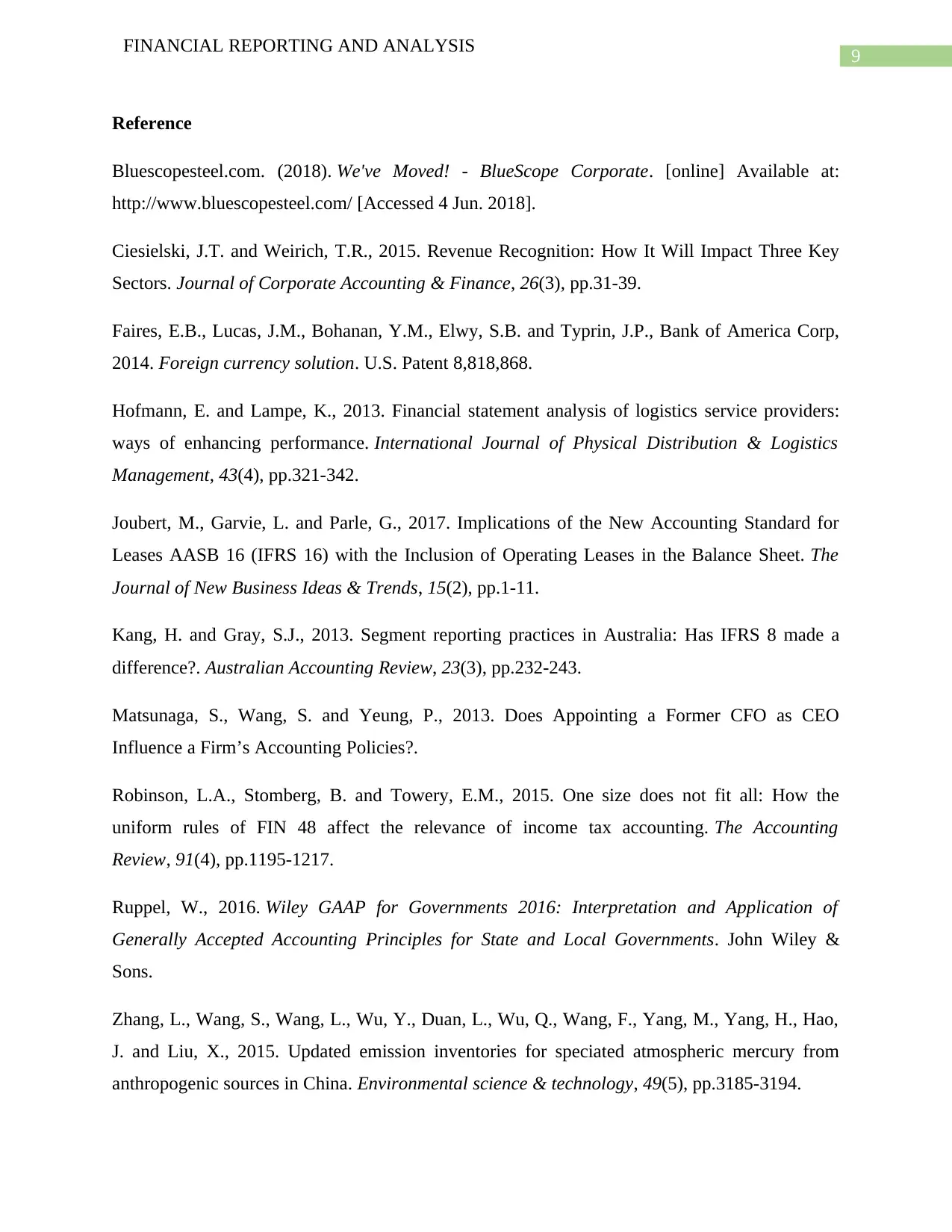
9
FINANCIAL REPORTING AND ANALYSIS
Reference
Bluescopesteel.com. (2018). We've Moved! - BlueScope Corporate. [online] Available at:
http://www.bluescopesteel.com/ [Accessed 4 Jun. 2018].
Ciesielski, J.T. and Weirich, T.R., 2015. Revenue Recognition: How It Will Impact Three Key
Sectors. Journal of Corporate Accounting & Finance, 26(3), pp.31-39.
Faires, E.B., Lucas, J.M., Bohanan, Y.M., Elwy, S.B. and Typrin, J.P., Bank of America Corp,
2014. Foreign currency solution. U.S. Patent 8,818,868.
Hofmann, E. and Lampe, K., 2013. Financial statement analysis of logistics service providers:
ways of enhancing performance. International Journal of Physical Distribution & Logistics
Management, 43(4), pp.321-342.
Joubert, M., Garvie, L. and Parle, G., 2017. Implications of the New Accounting Standard for
Leases AASB 16 (IFRS 16) with the Inclusion of Operating Leases in the Balance Sheet. The
Journal of New Business Ideas & Trends, 15(2), pp.1-11.
Kang, H. and Gray, S.J., 2013. Segment reporting practices in Australia: Has IFRS 8 made a
difference?. Australian Accounting Review, 23(3), pp.232-243.
Matsunaga, S., Wang, S. and Yeung, P., 2013. Does Appointing a Former CFO as CEO
Influence a Firm’s Accounting Policies?.
Robinson, L.A., Stomberg, B. and Towery, E.M., 2015. One size does not fit all: How the
uniform rules of FIN 48 affect the relevance of income tax accounting. The Accounting
Review, 91(4), pp.1195-1217.
Ruppel, W., 2016. Wiley GAAP for Governments 2016: Interpretation and Application of
Generally Accepted Accounting Principles for State and Local Governments. John Wiley &
Sons.
Zhang, L., Wang, S., Wang, L., Wu, Y., Duan, L., Wu, Q., Wang, F., Yang, M., Yang, H., Hao,
J. and Liu, X., 2015. Updated emission inventories for speciated atmospheric mercury from
anthropogenic sources in China. Environmental science & technology, 49(5), pp.3185-3194.
FINANCIAL REPORTING AND ANALYSIS
Reference
Bluescopesteel.com. (2018). We've Moved! - BlueScope Corporate. [online] Available at:
http://www.bluescopesteel.com/ [Accessed 4 Jun. 2018].
Ciesielski, J.T. and Weirich, T.R., 2015. Revenue Recognition: How It Will Impact Three Key
Sectors. Journal of Corporate Accounting & Finance, 26(3), pp.31-39.
Faires, E.B., Lucas, J.M., Bohanan, Y.M., Elwy, S.B. and Typrin, J.P., Bank of America Corp,
2014. Foreign currency solution. U.S. Patent 8,818,868.
Hofmann, E. and Lampe, K., 2013. Financial statement analysis of logistics service providers:
ways of enhancing performance. International Journal of Physical Distribution & Logistics
Management, 43(4), pp.321-342.
Joubert, M., Garvie, L. and Parle, G., 2017. Implications of the New Accounting Standard for
Leases AASB 16 (IFRS 16) with the Inclusion of Operating Leases in the Balance Sheet. The
Journal of New Business Ideas & Trends, 15(2), pp.1-11.
Kang, H. and Gray, S.J., 2013. Segment reporting practices in Australia: Has IFRS 8 made a
difference?. Australian Accounting Review, 23(3), pp.232-243.
Matsunaga, S., Wang, S. and Yeung, P., 2013. Does Appointing a Former CFO as CEO
Influence a Firm’s Accounting Policies?.
Robinson, L.A., Stomberg, B. and Towery, E.M., 2015. One size does not fit all: How the
uniform rules of FIN 48 affect the relevance of income tax accounting. The Accounting
Review, 91(4), pp.1195-1217.
Ruppel, W., 2016. Wiley GAAP for Governments 2016: Interpretation and Application of
Generally Accepted Accounting Principles for State and Local Governments. John Wiley &
Sons.
Zhang, L., Wang, S., Wang, L., Wu, Y., Duan, L., Wu, Q., Wang, F., Yang, M., Yang, H., Hao,
J. and Liu, X., 2015. Updated emission inventories for speciated atmospheric mercury from
anthropogenic sources in China. Environmental science & technology, 49(5), pp.3185-3194.
1 out of 10
Related Documents
Your All-in-One AI-Powered Toolkit for Academic Success.
+13062052269
info@desklib.com
Available 24*7 on WhatsApp / Email
![[object Object]](/_next/static/media/star-bottom.7253800d.svg)
Unlock your academic potential
Copyright © 2020–2025 A2Z Services. All Rights Reserved. Developed and managed by ZUCOL.




